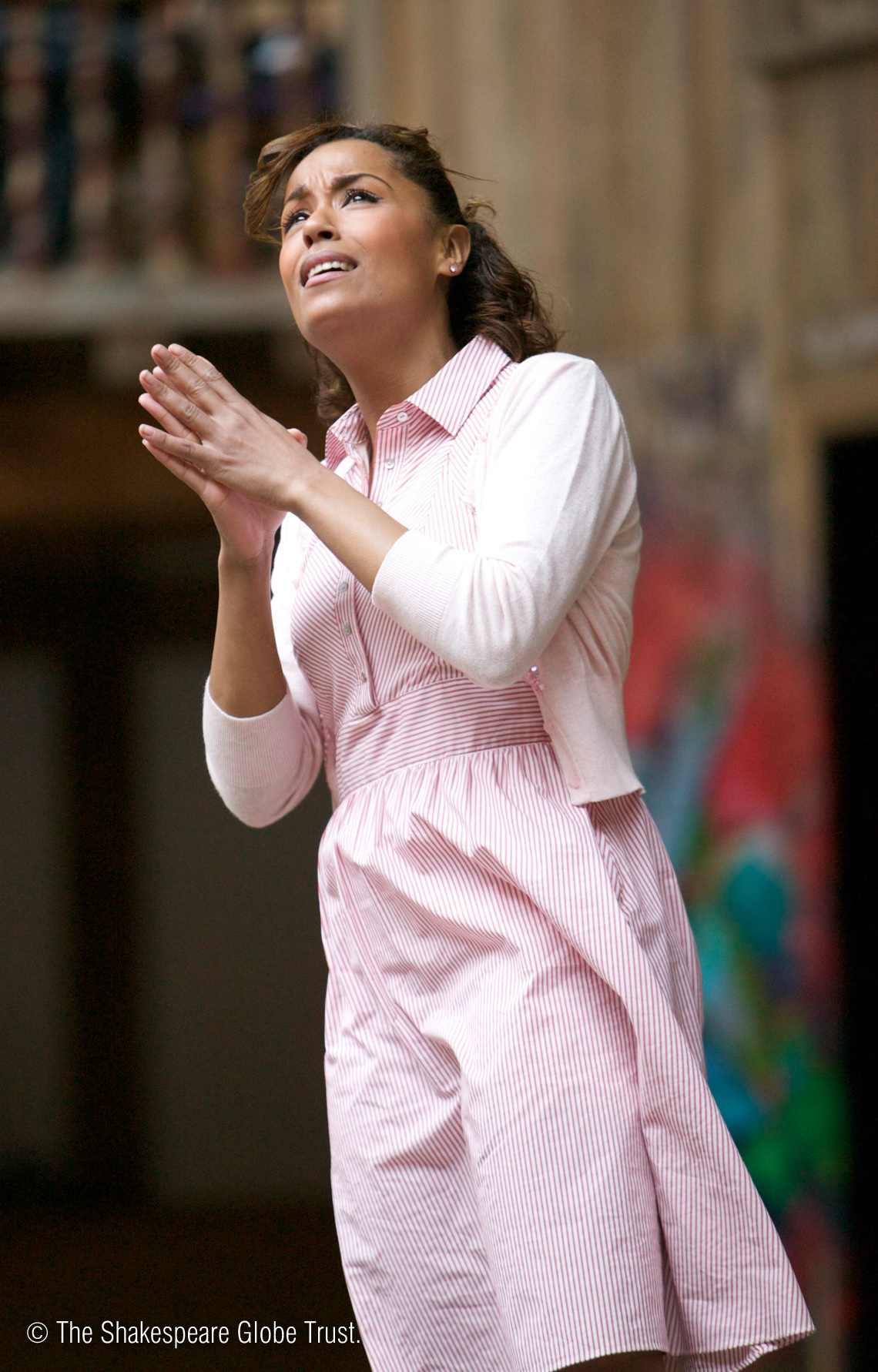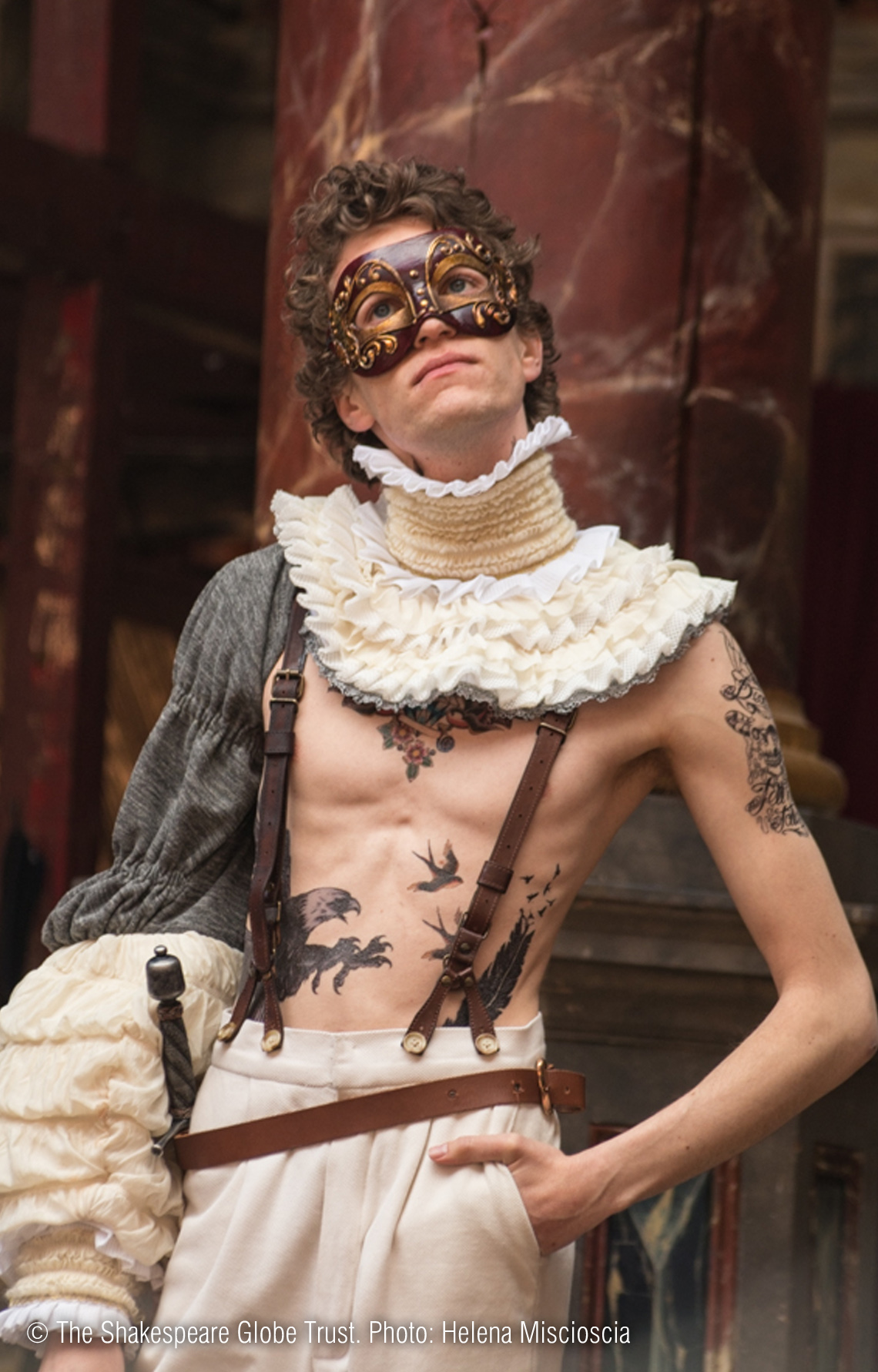In these lessons, students will examine the key characters in Romeo and Juliet and their dramatic functions. Tasks include: examining these two households 'both alike in dignity' and their social standings; exploring an audience's first impressions of Romeo; and how actresses have approached playing the role of Juliet.
In order to benefit fully from these lesson plans, we recommend you use them in the following order:
- Text in Performance
- Language
- Characters
- Themes
- Contexts
If students are new to the play, we suggest you start with these introductory KS3 Lesson Plans. If you would like to teach the play in greater detail, use the advanced KS4/5 Lesson Plans.
These lesson plans are available in the Downloads section at the bottom of this page. To download resources, you must be logged in. Sign up for free to access this and other exclusive features. Activities mentioned in these resources are available in a separate downloadable 'Student Booklet', also at the bottom of this page. The 'Teachers' Guide' download explains how best to use Teach Shakespeare and also contains a bibliography and appendices referencing the resources used throughout.
Key Questions for Students:
Can I explain how status is shown on stage?
Can I infer from the first scene of the play insights about life and society in Verona?
Can I establish the status of the characters in Romeo and Juliet in relation to each other?
Key words: body language, characters, conflict, costume, motivation, music, relationships, power, rank, society, status, voice
Prologue: Opening Discussion
Begin by asking students what status means to them and derive from students a working definition of the word ‘status’. Surround the word with some synonyms and other connected words, e.g. power, rank, position, hierarchy, chain of command. The template for this task can be found in the Student Booklet. Allocate different contexts to students, and ask them to draw a diagram to show the different roles people play within that context and their status in relation to each other. Contexts could include: a school; a hospital; a family; a chain of shops; an army; a football team; a state; a film studio; a fashion house. What matters is to choose contexts that will be interesting and meaningful to the class.
Enter the Players: Group Tasks
1) Status
Fiona Banks describes a selection of status games in Creative Shakespeare. This game, involving a pack of playing cards, will support students’ understanding of rank and status in the play. It is also effective way of leading into discussions about status within the state of Verona and within individual families.
Explain that high numbers from the pack of cards denote high status, whereas a low number such as an ace denotes low status. Students will be given a playing card and should hold it to their head without looking at it. They will walk around the room for a few minutes and see how other students react to them. Finally, students should line up according to what they think their status is and then altogether check to see the number on their card. Draw out in the ensuing discussion how status can be shown on stage and say that as well as being about someone’s title, appearance, how they speak, behave, etc. it is also shown by how others react to and behave around them.
2) Verona society
Students should turn to their Dramatis Personae page in the Student Booklet. Ask students to create a diagram to illustrate the status/social class of the various characters. Show how the two feuding families have equal status, being ‘both alike in dignity’. Referring back to the previous learning sequence, draw students’ attention to the numerous servants and other characters of lower rank in the play. Look together at how in Act 1 Scene 1 Shakespeare shows us that the conflict between the two households goes on between every social class.
3) Text detectives: characters of lower rank
In Romeo and Juliet, Shakespeare depicts characters from different social classes including many servants. Several of these servants have names and/or developed characters. Assign to different groups of students the following characters, and ask them to prepare brief presentations about them:
- the Nurse
- Peter
- Balthasar
- Abraham
- The servingmen at the Capulet party
- Sampson and Gregory
- three musicians
- the Apothecary
- the Watch

Consider:
- what they do for a living
- anything else we know about them
- their dramatic function in the play
Students can make notes on the relevant page in the Student Booklet, and then present their findings to the class.
Exeunt: Closing Questions for Students
What different kinds of power do characters have over each other in Romeo and Juliet?
How could this be shown on stage?
What are the effects of presenting such a wide range of characters from across the social spectrum?
Suggested plenary activity…
Students fill in a simple grid with four boxes: movement and body language; music; voice; costume. This can be found in the Student Booklet.

Students choose a character at a particular point in the play and think about how a character’s status could be shown using these elements of stagecraft, making notes in the boxes. Choose a few students to feedback.
Aside: Further Resource
- There are more activities about Juliet’s servant the Nurse in the Key Stage 4 Characters resource.
Epilogue: Teacher's Note
The presentation task for Activity 3 could be assessed for speaking and listening/reading.
Key Questions for Students:
Can I comment on the audience’s first impressions of Lord and Lady Capulet and Lord and Lady Montague in Act 1 Scene 1?
Can I investigate what we learn about Capulet and Montague, and about the feud between their families as the play moves on?
Can I comment on how Prince Escalus deals with the feud between the two families?
Key words: archetypes, audience, character, feud, scene, speech
Prologue: Opening Discussion
Share with students the following four character archetypes, taken from Fiona Banks’ book Creative Shakespeare: sovereign, warrior, carer, trickster.
Sovereign: Key characteristics: upright and responsible
The sovereign wears a crown, which is formed by placing your hands either side of your head, palms touching the top of your ears and fingers pointing upright. The sovereign wears a cape on which rest all the responsibilities of the kingdom.
Warrior: Key characteristics: alert and ready for action
The warrior carries a shield which s/he holds in his/her left hand, protecting the heart. The warrior’s hand is raised straight up, vertically at his/her side with fingers pointed upwards, representing a sword.
Carer: Key characteristics: selfless and open
The carer walks around the room and when s/he meets another person flings open his/her arms in a wide gesture. Arms should be stretched as wide as possible, resembling the upper part of a cross.
Trickster: Key characteristics: naughty, a joker, likes to divert attention
The trickster walks around the room, and when they see another person they turn or spin round to the left, look at the other person and click their fingers.
The poses which represent each archetype can be found in the downloable Lesson Plans at the bottom of this page. Devise a mime to accompany each archetype. Encourage students to remember and use these archetypes as they analyse the characters in the play.
Enter the Players: Group Tasks
1) First impressions
Students should read the following short passage from Act 1 Scene 1 lines 73-78 in groups of four. The extract can be found in the Student Booklet.
Enter old Capulet in his gown, and his Wife.
CAPULET: What noise is this? Give me my long sword, ho!
CAPULET'S WIFE: A crutch, a crutch! Why call you for a sword?
[Enter old Montague and his Wife.]
CAPULET: My sword, I say. Old Montague is come,
And flourishes his blade in spite of me.
MONTAGUE: Thou villain, Capulet! Hold me not, let me go.
MONTAGUE'S WIFE: Thou shalt not stir one foot to seek a foe.
Students can experiment with different ways to perform these lines, perhaps using the archetypes as described in the Prologue to this learning sequence. How would the different ways of performing these lines affect the audience’s first impressions of these four characters, of the nature of the longstanding feud between them, and of the overall mood at the start of the play?
2) Text detectives: Capulet
Explain to students that they are going to be discussing how Capulet might be played in a production of Romeo and Juliet. Students should work in groups and choose two scenes to focus on which show different aspects of Capulet’s character. They should compare and contrast Capulet's character in the two scenes. Scenes to select from include:
- Act 1 Scene 5
- Act 3 Scene 4
- Act 3 Scene 5
- Act 4 Scene 4
- Act 4 Scene 5
- Act 5 Scene 3
Students might also like to consult sources on the Globe website, including the Adopt An Actor archive of actor interviews, production images, etc.

3) Prince Escalus
How effective is Prince Escalus in putting a stop to the hatred and violence that exists between the Montagues and Capulets? Read Escalus’ speech in Act 1 Scene 1 (available in the Student Booklet), and examine the prince’s language and intentions, making annotations on the text. Ask students to repeat this activity for his speeches in Act 3 Scene 1 and Act 5 Scene 3. Students could form an inquiry to see whether there is anything more he could or should have done to keep the peace.
Exeunt: Closing Questions for Students
To what extent are the Capulets and Montagues victims of the feud?
To what extent do their actions perpetuate and worsen a hostile state of affairs?
Is Prince Escalus strong or weak in the way he deals with the feud?
How would I portray these characters if I were staging the play?
Suggested plenary activity…
Students should choose one of the following characters, all of whom give instructions and advice during the play: Lord Montague, Lady Montague, Lord Capulet, Lady Capulet, and Prince Escalus. What advice would students give them in their role as head of a principality/head of household/leader/parent? Share ideas among the class.
Aside: Further Resource
- There is an interesting text about the differences between the older and younger generations in the play on the Playing Shakespeare with Deutsche Bank Romeo and Juliet microsite: 2013.playingshakespeare.org/language.html.
Epilogue: Teacher's Note
The plenary activity could be developed into a creative writing task, perhaps in the form of an agony aunt letter and reply. There are more activities about Romeo and Juliet’s parents within the Key Stage 4 materials under Themes.
Key Questions for Students:
Can I describe Romeo’s character and explain what motivates him?
Can I analyse some of the language he uses to support my views?
Key words: analyse, archetype, banishment, character, calligram, context, courtly love, motivation, romantic love
Prologue: Opening Discussion
As an introduction to this lesson, you could play ‘Lovefool’ by The Cardigans, one of several songs used in the Baz Luhrmann film Romeo + Juliet. Show students the following information about the Elizabethan view of romantic love:
In this scene, Benvolio and Romeo discuss how love can make a man act like a madman. Elizabethans had complicated ideas about romantic love. People were encouraged to love their husband or wife. However, loving someone too much was seen as an illness. Elizabethan doctors saw unrequited love or desire as a disease, a type of melancholy sometimes called lovesickness. It was caught through the eye. Symptoms of lovesickness were: fever, mood swings and even shrinking of the heart. Medical writings treated lovesickness as a common disease. Doctors tried various cures. They changed the patient’s diet, and gave them herbal medicines. They sometimes sent patients to church, to confess to a priest. They believed that, if lovesickness was left untreated, it could lead to madness.
The lovesick man was a popular character in early modern literature. Shakespeare makes the connection between love and madness again in Hamlet, when Polonius believes Hamlet to be mad because of his love for Ophelia.
Ask students to bear this contextual information in mind as they read Act 1 Scene 1 and learn about Romeo’s feelings for Rosaline.
Enter the Players: Group Tasks
1) First impressions
Act 1 Scene 1 ends with the appearance of Romeo. Students could work in small groups, each focusing on a section of the scene. Some students should read it and while others listen, repeating any word or phrase which tells us something about Romeo:
- lines 97-139
- lines 140-177
- lines 177-202
- lines 203-232
Students should listen actively to the feedback from all the groups. and draw up an evidence sheet showing (from throughout the scene):
- what Romeo’s parents say about him
- what Romeo’s friends say about him
- what Romeo says about himself
Conclude this activity by discussing what the audience’s first impressions of Romeo’s personality and character might be and why, recording students’ findings in the Student Booklet.

2) Archetypes
Look again at Fiona Banks’ four character archetypes, mentioned in the previous learning sequence. Ask students to read Act 3 Scene 1 closely in groups of four. They should find quotations which demonstrate each of the four archetypes in Romeo’s character, with each student reading the text through the particular ‘lens’ of one archetype. Example quotations:
'Gentle Mercutio put thy rapier up' (sovereign) (line 83)
'…fire-eyed fury be my conduct now' (warrior) (line 126)
'I…love thee better than thou canst devise' (carer) (line 68)
'Courage, man. The hurt cannot be much.' (trickster) (line 97)
As Banks says, this is ‘a really useful way of looking at character change/progression within one scene’. N.B. Ways of differentiating this task to make it more accessible include: creating quotation cards and asking students to sort them under the archetype headings; or highlighting within the script some key quotations for students to pause and consider.
3) Romeo as lover, Romeo as killer
According to Fiona Banks, this activity is ‘a quick method of charting a character’s journey through the play’. Students should begin by making two lists about Romeo the lover and Romeo the killer (in the form of direct quotations from the play). The students should arrange themselves into two lines facing each other. Give each student a quotation from the ‘Romeo the lover’ list to repeat and remember. Then pairs of students take it in turns to walk down between the two lines, as the other students repeatedly say their quotations. At the end of their walk, another pair begins their walk and the original pair joins the two lines again. Once everyone has had a turn, students can reflect together on the language they have heard and how it affected them. Repeat with the ‘Romeo the killer’ words and phrases.
Exeunt: Closing Questions for Students
What do we learn about Romeo as the play progresses?
How would I describe his character?
What motivates him?
What evidence might I use to support these ideas?
Suggested plenary activity…
Students design calligrams based on some key words taken from quotations by Romeo. Students explain why they chose that particular quotation and word.
Asides: Further Resources
- Romeo’s first love Rosaline is one of the play’s absent characters in that she is mentioned but doesn’t appear. Why do students think Shakespeare doesn’t include her as a character?
- Romeo’s unrequited love for the idealised Rosaline can be described as the medieval tradition of ‘courtly love’.
Epilogue: Teacher's Note
More activities about Romeo can be found within the Key Stage 4 materials under Text in Performance and Language.
Key Questions for Students:
Can I describe Juliet’s character and explain what motivates her?
Can I analyse some of the language she uses to support my views?
Key words: analyse, character, calligram, context, love, motivation, rebellion
Prologue: Opening Discussion
Students could read the following three extracts from the Adopt An Actor archive (shakespearesglobe.com/adopt-an-actor), which can be found in the Student Booklet. They are from interviews with three actors who have played Juliet: Kananu Kirimi,Cassie Layton, and Ellie Piercy. Ask each student to pick out one insight into Juliet’s character they have gleaned from reading these comments:
“You start off thinking of Juliet as a little girl who's very sweet and unknowing. I suppose I’m remembering that at that age you’re quite into boys and that it's not such a big surprise for someone to like you because you’re a woman. Juliet might have imagined what a husband would be like; that's a fairly new thought for her. She's sweet but she also might be aware of desire. When her mother asks ‘How stands your disposition to be married?’ and Juliet responds ‘It is an honour that I dream not of’ [I.3.67-7], she might be holding back. When we’re confronted with a question and we’re not sure where it's going to lead, we’re often quite reserved. We fit our answer to suit the person who asked the question.” – Kananu Kirimi (2004)
“her darker side is much more prominent than I thought it would be. Because I think as the youngest of Shakespeare’s heroines she's often given a – maybe wrongly I think, sometimes portrayed as quite innocent and naïve. And she does have that side to her but she’s also very brave and she grows up a he amount during the play as well. But she’s got this gothic dark side that she loves to bask in.” – Cassie Layton, 2015
“My Juliet had become a very determined fighter. She was passionate, emotional, fragile and strong. Had we not taken this show on tour I don’t think she would have become so ingrained and real. The process of fighting against our outdoor environments, having to create and sustain our worlds using ourselves alone had taken our characters to quite different heights.” – Ellie Piercy, 2007
Enter the Players: Group Tasks
1) First impressions
The audience sees Juliet for the first time in Act 1 Scene 3. Read lines 64-100 and discuss the following questions:
- What reasons does Juliet’s mother give Juliet for marrying Paris?
- How does Juliet respond to the advice?
- What is an audience’s first impression of Juliet’s relationship with both her mother and with her nurse?

2) The rebellious daughter
Before analysing Juliet’s language in Act 3 Scene 5 in detail, students could read the following contextual information in the Student Booklet:
Shakespeare’s audience lived in a world where the father or husband was the head of the household, and in charge of the family. The Church taught that children should obey their parents, and wives should submit to their husbands. Both Lady Capulet and Juliet were expected to obey Capulet in everything. Many parents were strict with their children to teach them discipline and respect. People thought spoiling children was wrong, because the children would become rude and selfish. Parents expected their children to be obedient and show their high social status to their neighbours.
Now read Act 3 Scene 5 as a class. Consider and then discuss:
- the boldness of Juliet’s behaviour and language in this scene
- the techniques Shakespeare uses to encourage the audience to sympathise with Juliet in this scene
3) Text detectives: ‘Rather than marry Paris’
Examine closely Juliet’s speech in Act 4 Scene 1 lines 77-88, where she lists all the things she would rather do than marry Paris. On the relevant page in the Student Booklet, students can explore the language Juliet uses here and her motivation at this point in the scene.

Students could also watch footage of this scene.
Exeunt: Closing Questions for Students
What do we learn about Juliet as the play progresses?
How would I describe her character?
What motivates her?
What evidence might I use to support these ideas?
Suggested plenary activity…
Students design calligrams based on some key words taken from quotations by Juliet. Students explain why they chose that particular quotation and word.
Asides: Further Resources
- Which word is missing from each of these Juliet quotations? This quiz can be found in the Student Booklet, and the answers are available in the downloadable Lesson Plan at the bottom of this page.
‘Good _______, you do wrong your hand too much’
‘Tis but thy name that is my ______.’
‘________ is such sweet sorrow
That I shall say goodnight till it be morrow.’
‘But my true _____ is grown to such excess,
I cannot sum up sum of half my wealth.’
‘I’ll to my wedding bed
And _____, not Romeo, take my maidenhead.’
‘It is the _____ that sings so out of tune.’
‘Good ______, I beseech you on my knees,
Hear me with patience but to speak a word.’
‘O bid me _____, rather than marry Paris.’
‘Love give me ________, and _________ shall help afford.’
‘Yea, noise? Then I’ll be brief. O happy ________!’
dagger
death
enemy
father
lark
leap
love
parting
pilgrim
strength
- Notice how Shakespeare creates an impression of Juliet as headstrong and determined from her very first (delayed) appearance. It takes both Lady Capulet and the Nurse several calls off stage to make Juliet stop whatever she is doing and appear on stage!
Epilogue: Teacher's Notes
More activities about Juliet can be found in the Key Stage 4 materials under Text in Performance, Language and Themes. The earlier part of Act 3 Scene 5 is the focus of an activity in these Key Stage 3 materials under Themes.
Key Questions for Students:
Can I write about a character of my choice and examine different aspects of their personality?
Can I comment on the extent to which Shakespeare has created a complex character?
Can I support my points with textual evidence?
Key words: audience, character, characterisation, complex, credible, interpretation, quotation, realistic, textual evidence, vice, virtue
Prologue: Opening Discussion
Students could draw a line about 20cm long and put at one end ‘Character I like most’ and at the other end ‘Character I like least’. Students should arrange as many characters from Romeo and Juliet along the line as possible, and be ready to justify their choices in a discussion. Students could then repeat this exercise with ‘Character I’d most like to play’ at one end of the line and ‘Character I’d least like to play’ at the other end. Take feedback, encouraging students to consider the differences between their two diagrams. Ask students to decide which character they would each like to study in depth.

Enter the Players: Group Tasks
1) Vices and virtues
Students should explore the different - and perhaps conflicting - traits of their chosen characters. Using a character outline to record points that emphasise their characters’ good and bad points, they should include quotations to back up their points in the space provided in the Student Booklet.

2) Adopt An Actor
Now students have a chance to learn from the perspectives of other actors who have played that part at the Globe Theatre. Using the Adopt An Actor archive (shakespearesglobe.com/adoptanactor), students can search for their chosen character and find information, podcasts, transcripts, blog entries and production images. These resources will help them become more familiar with their character, and inform them on how best to interpret that part on stage.
3) Challenging roles
In the Student Booklet, there is a page called Challenging Roles. This can be used as a note-taking and planning page for a piece of writing about taking on a challenging Shakespearean role. Students can choose any character from the play and the aim is:
- to write from the point of view of an actor preparing to play that part
- to write a short introduction describing this character and their role in the play
- to draw attention to different aspects of the character
- to include some quotations to support main points
Exeunt: Closing Questions for Students
What are the good and bad points about my chosen character?
Has Shakespeare created a believable character?
Can I identify or empathise with my chosen character in any way?
What advice would I give to an actor playing the part I have chosen to write about?
Suggested plenary activity…
Self or peer assess work in progress for ‘Challenging roles’.
Epilogue: Teacher's Note
The ‘Challenging roles’ activity in the Student Booklet could be assessed for reading and writing.
